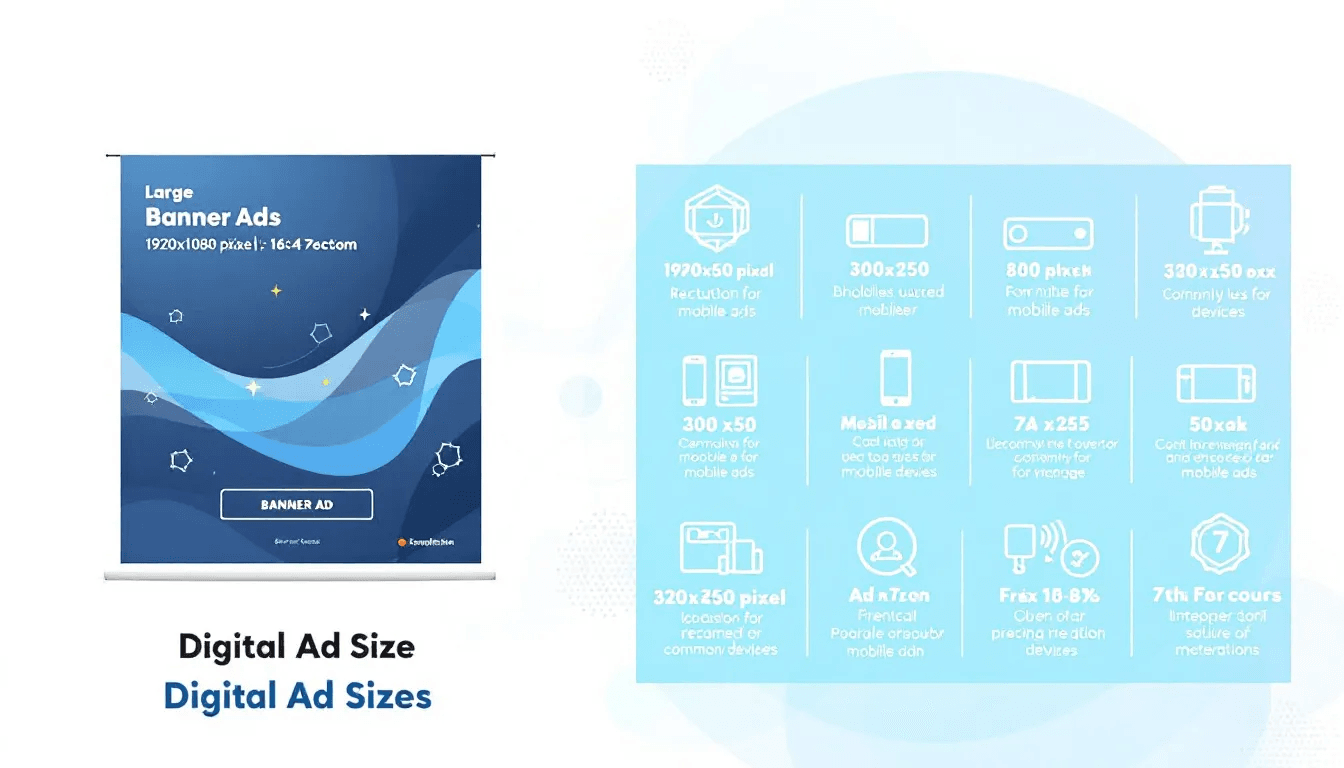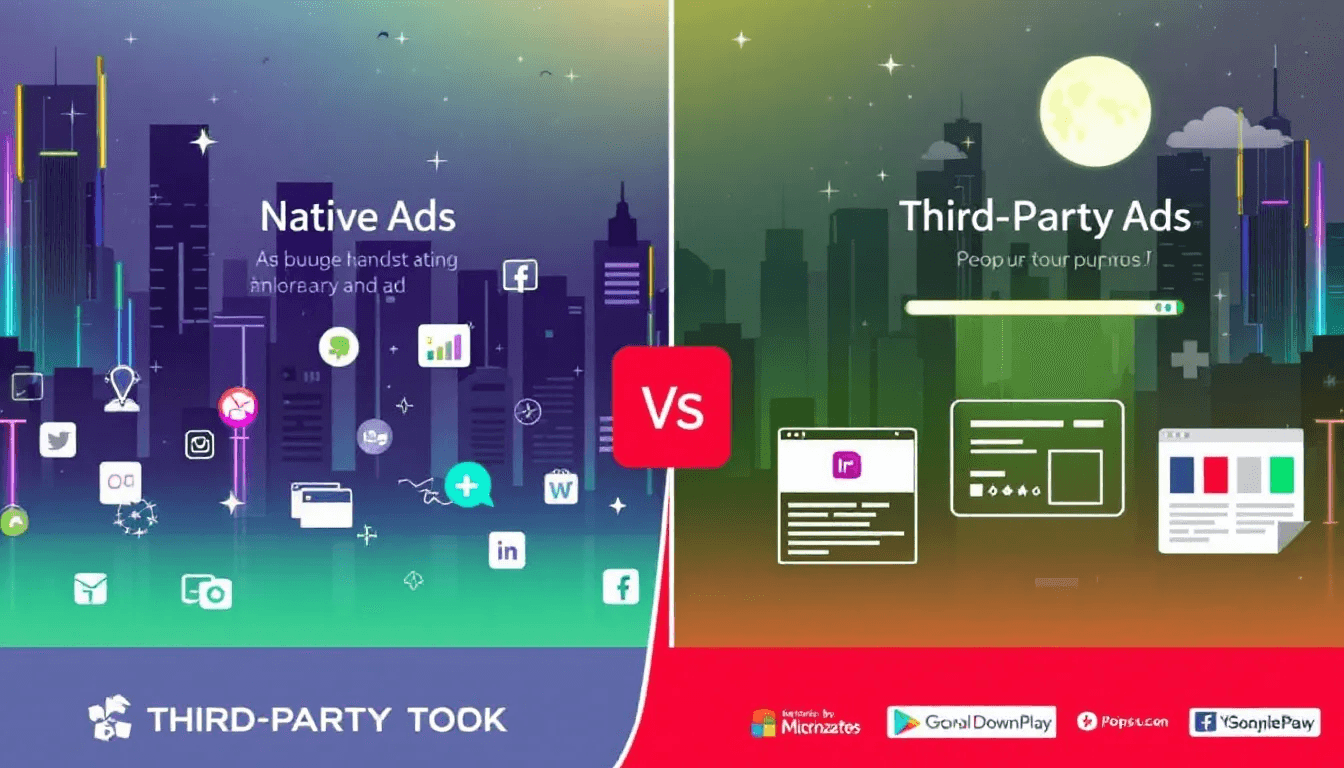Picture digital ad specs as the ultimate rulebook for your advertising game, laying out the dimensions, formats, and criteria your ads need to hit a home run on different platforms. There are a TON to remember, but you don't really have a choice. We can help.
We put together a guide that will become your secret weapon for mastering Google, Facebook, and Instagram ads, helping you boost their effectiveness and reach like a pro. You ready?
Why Digital Ad Specs Matter
Digital advertising is not just about creating visually appealing ads—it’s about optimizing those ads for different platforms and devices. Nothing ruins the vibe of a great creative asset than it being sized incorrectly for the platform it appears (black box, no thanks). Each ad placement has a specific dimension, file size, aspect ratio, and format requirement that impacts how it is displayed and performs.
Ad clarity and professionalism: Ads that are improperly sized can appear stretched, blurry, or cropped, making them look unprofessional.
Maximizing performance: Ads optimized for the right format load faster and perform better, increasing click-through rates (CTR) and conversions.
Compliance with platform rules: Social media and ad networks have strict guidelines. If your ad doesn’t meet the requirements, it may be disapproved or penalized in auctions.
Better user experience: Well-optimized ads appear seamlessly across different screen sizes and devices, improving engagement.
Efficient budget use: A properly formatted ad ensures higher engagement and lower cost-per-click (CPC), maximizing ROI.
Understanding the Different Types of Digital Ads

Not all digital ads serve the same purpose. Different ad formats exist for brand awareness, engagement, conversions, and retargeting. Understanding each type is key to choosing the best format for your marketing goals.
a) Social Media Ads
- Found on platforms like Facebook, Instagram, LinkedIn, TikTok, and Twitter/X.
- Can include static images, videos, carousels, stories, and in-feed posts.
- Designed for engagement (likes, shares, comments) and conversions (website clicks, lead generation).
b) Display Ads
- Appear as banner ads across websites within ad networks (Google Display Network, programmatic ads).
- Can be static images, animated GIFs, or HTML5 ads.
- Used primarily for brand awareness and retargeting.
c) Retargeting Ads
- Target users who have previously visited your website or engaged with your content.
- Can appear on social media, display networks, and search engines.
- Effective for recapturing lost leads and increasing conversion rates.
d) Native Ads
- Blended into website or app content to look like editorial content.
- Found on platforms like Outbrain, Taboola, and LinkedIn Sponsored Content.
- Designed to be non-disruptive and drive higher engagement.
e) Search Ads
- Appear in Google Search, Bing Ads, and other search engines.
- Text-based ads that show up when users search for relevant keywords.
- Best for high-intent searches and lead generation.
f) Video Ads
- Found on YouTube, social media, and programmatic platforms.
- Typically higher engagement and view-through rates than static ads.
- Require specific formats, resolutions, and lengths to perform well.
Understanding Digital Ad Sizes
When it comes to digital ads, the size really does matter! Getting the right dimensions for your ads is key to making sure they shine on different platforms and catch the eye of your audience. Think of it like picking the perfect outfit for a big event—it needs to fit just right to make a great impression. Choosing the wrong size can be like wearing shoes that are too tight; it leads to discomfort and might even cause your ads to be less visible and engaging.
Knowing the usual ad sizes for various platforms and understanding how mobile ads differ from those meant for desktop use is super important. It's like knowing the difference between a casual get-together and a formal dinner—you wouldn't wear the same thing to both! This knowledge helps you make smart choices that boost your ad's performance, ensuring your message hits home with your target audience.
Common Ad Sizes Across Platforms
Commonly recognized ads sizes ensure compatibility and peak performance on major platforms. The frequently utilized dimensions include:
- Medium Rectangle (300x250)
- Large Rectangle (336x280)
- Leaderboard (728x90)
- Skyscraper (120x600)
- Wide Skyscraper (160x600)
Platforms such as Google Ads and Microsoft Advertising support these measures, allowing them to be used across different advertising networks effectively.
Banner ads like the Medium Rectangle (300x250) and Large Rectangle (336x280) are endorsed by Google Ads. Similar standards apply in Microsoft Advertising along with other third-party networks for consistent usability throughout various websites and applications.
Becoming acquainted with these prevalent ad sizes is crucial when aspiring to craft digital advertisements that grab attention and spur interaction.
Mobile vs Desktop Ad Sizes
Think of the online world as divided into two camps: mobile and desktop. Each has its own unique ad dimensions, just like how you wouldn't wear the same outfit to a beach party and a formal dinner. Mobile ads need to be designed for smaller screens, focusing on looking good and being easy to interact with on your phone. Meanwhile, desktop ads can spread out a bit more, allowing for richer content and more intricate designs.
It's super important for marketers to tweak their ad strategies to match the screen size and specs of the devices their audience is using. This way, they can boost the user experience and the results of their campaigns. For example, the Large Mobile Banner (320x100) is perfect for mobile screens, while the traditional Leaderboard (728x90) is meant for desktop monitors.
By choosing the right ad sizes for each device type, you ensure your ads are not just efficient but also eye-catching and engaging.
A Quick Look: Ad Specs for Top Digital Platforms
Each platform has its own static and video ad specifications that must be followed to ensure optimal performance. Below is a high-level breakdown. Consider it the "sparknotes" of this article. But if you'd like to learn more details about effectively executing ads on each platform, keep reading.
a) Facebook & Instagram
Static Ads
- File Types: JPG, PNG
- Recommended Dimensions: -- 1080 x 1080 px (square) -- 1200 x 628 px (landscape)
- Max File Size: 30MB
- Aspect Ratios: -- 1:1 (square) – best for feed ads -- 4:5 (portrait) – best for mobile -- 16:9 (landscape) – best for wide placements
Video Ads
- File Types: MP4, MOV, GIF
- Recommended Dimensions: -- 1080 x 1080 px (square) -- 1080 x 1920 px (vertical for Stories/Reels)
- Max File Size: 4GB
- Video Length: 1 second to 241 minutes (recommended under 15 seconds)
b) Google Display & YouTube
Static Display Ads
- File Types: JPG, PNG, GIF
- Recommended Sizes: -- 300x250 px (Medium Rectangle) -- 728x90 px (Leaderboard) -- 160x600 px (Skyscraper)
- Max File Size: 150KB
YouTube Video Ads
- File Types: MP4, MOV
- Recommended Resolution: 1920 x 1080 px
- Max File Size: 128GB
- Video Length: -- Skippable ads: 15 seconds – unlimited -- Non-skippable ads: Max 15 seconds -- Bumper ads: 6 seconds
A Deep Dive into Platform-Specific Ad Specs

Google Ads
The good news: there are tons of Google ad options out there. The bad news: they all have their own specs to know. Responsive display ads and uploaded image ads each come with their own specific guidelines to ensure optimal performance on the Google Display Network.
Responsive Display Ads: Responsive display ads automatically adjust their size, appearance, and format to fit available ad spaces. They require you to provide multiple assets, including:
- Images: Landscape images should be 1200 x 628 pixels, and square images need to be 1200 x 1200 pixels. Ensure the images are in JPG, PNG, or SVG formats and do not exceed 5 MB.
- Logos: Square logos should be 1200 x 1200 pixels, and landscape logos 1200 x 300 pixels, also in JPG, PNG, or SVG formats, with a max file size of 5 MB.
- Text: Include short headlines (up to 30 characters), long headlines (up to 90 characters), descriptions (up to 90 characters), and a business name (up to 25 characters).
- Video: Optionally, you can add a video asset to enhance engagement.
Uploaded Image Ads: These ads allow you to design your own images and upload them directly. They must adhere to specific size and format requirements:
- Sizes: Common sizes include 300 x 250 (Medium Rectangle), 728 x 90 (Leaderboard), and 160 x 600 (Skyscraper).
- Formats: Acceptable formats are JPG, PNG, and GIF.
- File Size: Ensure the file size does not exceed 150 KB.
Following these specs not only keeps Google happy but also makes sure your ads grab attention and perform like you want them to. Whether you're going with responsive or uploaded image ads, sticking to these guidelines will definitely boost your campaign's impact.
Facebook Ads
Facebook likes Facebook. Ads offer multiple ad formats, including image ads, video ads, carousel ads, and stories ads. Image of Image. Ads for the feed must be in JPG or PNG file format with a maximum file size of 30 MB. These ads require an aspect ratio of 1:1 (square) or 4:5 (vertical) and a recommended primary text of up to 125 characters.
Video ads for the feed must have a resolution of at least 1080 x 1080 pixels and can have a video length from 1 second to 241 minutes, with a maximum file size of 4 GB.
Carousel ads on Facebook must have a resolution of at least 1080 x 1080 pixels and can contain between 2 to 10 images or videos. These ads require an aspect ratio of 1:1 (square) and can have a video length of up to 240 minutes.
Stories ads must have a resolution of at least 1080 x 1920 pixels and can be in JPG, PNG, MP4, MOV, or GIF file formats. These ads also require an aspect ratio of 9:16 (Vertical) and can have a video length from 1 second to 2 minutes.
Following these specifications ensures your Facebook account. Ads are visually appealing and capture your audience’s attention. Each ad format has unique guidelines, and understanding these helps you create ads that perform well on the platform.
Instagram Ads
Instagram has become a popular social media platform. Ads also offer various ad formats, including image ads, video ads, stories ads, and reels ads. Image. Ads for the feed must have a resolution of at least 1080 x 1080 pixels and be in JPG or PNG file format. These ads recommend primary text of up to 125 characters and allow a maximum number of 30 hashtags.
Video for the feed can have a video ad length from 1 second to 60 minutes, must have a resolution of at least 1080 x 1080 pixels, and can be in MP4, MOV, or GIF file format.
Stories on Instagram require an aspect ratio of 9:16 (Vertical), a resolution of at least 1080 x 1080 pixels, and can have a video length from 1 second to 60 minutes. These ads must be in JPG or PNG file format for images and MP4, MOV, or GIF file format for videos.
Reels require an aspect ratio of 9:16 (Vertical), must be in MP4, MOV, or GIF file format, and have a max file size of 4 GB. These ads recommend a headline of up to 55 characters and primary text of up to 40 characters.
Knowing these specifications ensures your Instagram account. Ads are optimized for the platform, enhancing visibility and engagement. Each ad format has its own guidelines, and adhering to them helps you create compelling ads that resonate with your audience.
Rich Media and Video Ads

Incorporating sophisticated ad formats like rich media and video ads into your advertising strategy can significantly boost user engagement and conversion rates. These ads offer interactive features and dynamic content that are much better at grabbing users' attention compared to traditional static ads. Rich media ads use animations and audio elements, such as stereo AAC audio compression, to ramp up viewer involvement, while video ads deliver messages quickly and persuasively.
Rich media ads can include cool elements like expandable banners, interstitials, and video components, offering a more immersive experience. These ads often support file types like HTML5, GIF, JPG, and PNG, with a maximum file size usually around 200KB, depending on where you're advertising. Using a fixed frame rate and square pixels helps ensure smooth playback and visual consistency across devices.
Video ads need a bit more attention to file formats and sizes to perform their best. Platforms typically accept MP4 or MOV formats, with a recommended resolution of 1920 x 1080 pixels for a clear picture. The max file size for video ads can go up to 4GB, allowing you to deliver high-quality content. Video ads should use progressive scan to avoid any annoying interlacing issues, ensuring a seamless viewing experience.
In this section, we'll dive into the nitty-gritty details and share some top tips for crafting standout video and rich media ads. By leveraging these advanced ad formats, you can create more captivating and influential advertising campaigns that really hit home with your target audience, boost brand visibility, and drive better results.
Video Ads
Video ads are like the rockstars of digital advertising, effectively communicating messages and capturing users' attention. These ads are usually capped at 30 seconds, with headlines limited to 50 characters and body text kept short at 50 words max. Using high-resolution images can significantly boost conversion rates, with HD imagery achieving a 60% improvement over lower-quality visuals. For video ads designed for large desktop displays, the rules are the same: keep videos under 30 seconds and headlines within 50 characters. Sticking to these specs is key to maximizing the impact and engagement of your video ads.
Rich Media Ads
Rich media ads are all about mixing things up with interactive elements like animations, videos, and audio to engage users in a more compelling way. They can be set up as standard or expandable formats, offering versatility in both design and user interaction. By incorporating rich media ads into your strategy, you can create ads that are not only dynamic but also highly engaging, leading to increased user attention and interaction.
Using these types of ads is particularly effective at prompting user engagement and ensuring your message resonates with your audience. Adding rich media elements to your campaigns can lead to heightened user involvement and an overall boost in campaign performance
Native and Third-Party Ads

Digital advertising is all about making the right choices, and that's where native and third-party ads come into play. Picture native ads as the friendly neighbor who fits right in with the community—they blend seamlessly with the content around them, making them less intrusive and more engaging for viewers. On the flip side, third-party ads can sometimes feel like that distant relative who just doesn't quite fit in, often running into compatibility issues that can lessen their impact. Let's dive into why native ads are awesome and some of the hurdles you might face with third-party ads. Understanding these can help you make savvy decisions about which ad styles to use in your campaigns.
Native Ads
Native ads are like the chameleons of the advertising world—they integrate so well with the surrounding content that they feel like a natural part of the editorial flow. This non-intrusive vibe means users are more likely to engage with them, often leading to better click-through rates and performance metrics.
By weaving native ads into your content, you can boost your brand's image and drive up those conversion rates. They're great at grabbing attention and encouraging interaction with your content.
Third-Party Ads
Now, third-party ads are crucial players in digital advertising, but they come with their own set of challenges. Compatibility issues across different platforms and devices can be a real headache, affecting both how these ads perform and how visible they are. Tackling these challenges head-on is key to making the most of third-party ads. Making sure third-party ads work smoothly across various systems and are easy for users to see can really enhance their performance. Nail this, and you'll likely see better results from your advertising campaigns.
Common Mistakes to Avoid in Digital Ad Creation
Many marketers lose ad performance due to simple mistakes. Here are common pitfalls:
Using incorrect dimensions, leading to distorted or cropped visuals. This can result in an unprofessional appearance, which diminishes the effectiveness of the ad and can negatively impact brand perception. Ensuring that your ads are designed to fit the specific dimensions required by each platform is crucial for maintaining visual integrity and maximizing engagement.
Exceeding file size limits, causing slow loading times. Large files can lead to delays in ad display, which might cause users to lose interest before the ad even loads. It's important to optimize file sizes to ensure quick loading times, enhancing the user experience and increasing the likelihood of interaction.
Not optimizing for mobile, reducing engagement rates. With a significant portion of users accessing content via mobile devices, it's essential to ensure that ads are mobile-friendly. This includes considering the smaller screen sizes and touch interfaces, which require ads to be easily viewable and clickable on mobile devices.
Lack of testing and iteration, missing opportunities to improve performance. Regularly testing different ad variations and iterating based on performance data is key to optimizing ad effectiveness. This process helps identify what works best for your audience, allowing for continuous improvement and better results over time.
Ignoring brand consistency, making it harder for users to recognize your brand. Consistent branding across all ads helps reinforce brand identity and fosters trust with your audience. Inconsistencies can confuse potential customers and weaken brand recognition, so it's important to maintain a cohesive look and feel in all advertising materials.
Key Takeaways
Navigating the intricacies of digital advertising specifications is a key component for success in the bustling realm of online marketing. A thorough grasp of prevalent ad sizes, requirements unique to each platform, and established methods for crafting impactful ads can markedly boost both your campaign’s visibility and user engagement. By fine-tuning imagery, pinpointing an appropriate audience, and persistently evaluating and refining your approach, you are equipped to produce advertisements that not only connect with users but also yield superior outcomes.
Advertisements featuring rich media or video provide enhanced interactive experiences. Likewise, native ads as well as those from third-party sources come replete with their own sets of benefits and potential obstacles. It is imperative to ensure that your advertisements adhere strictly to standards ensuring quality control so as to preserve credibility while maximizing performance effectiveness.
Adhering closely to the detailed instructions laid out in this manual will enable you to effectively tackle the complexities associated with digital advertisement specifications. Construct persuasive adverts tailored toward achieving your commercial goals by employing these recommended practices — thereby propelling your ventures into higher realms within the landscape of digital marketing.
How Assemble Studio Can Help You Create Perfect Ads
At Assemble Studio, we specialize in creating high-performing digital ads that align with platform specifications and drive results. We also make creative production a lot simpler with top technical prowess and the lates tools that expedite the delivery and enhance the quality of your assets. Whether you need static banners, animated HTML5 ads, social media creatives, or video content, we ensure your ads are:
- Optimized for all platforms with pixel-perfect designs.
- Engaging and conversion-focused, increasing your return on ad spend.
- Tested for compliance, ensuring approval on ad networks.
Ready to really stand out? Contact us today to discuss your project goal.

